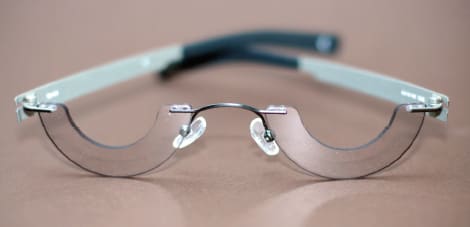Lenses: The Latest Developments
Get ready for these game-changing developments—all of which deeply impact your whole practice, but mostly your lens business. The end result will be providing different patient care and dispensing
Karlen McLean, ABOC, NCLC
New lens developments are as much about what surrounds a lens product as the lens itself. Medical equipment and measuring has typically been confined to the pre-test room and exam lane. Now it's moving to the dispensary, too.
Ground-breaking eyewear options featuring lenses are currently available, including electronic, liquid, and custom-curved. What was once considered niche lenses like for sports or computer use are now “super niched”—niches within a specific niche.
Eyeglass shopping and dispensing have traditionally been conducted via brick-and-mortar; now, just like the cutting-edge of consumer lens education, some of it's shifting to online.
And as mergers and acquisitions and new ways of doing business continue to rapidly evolve in the lens market, how can you do business with the new entities, compete with them, or learn from them? Here are a few examples.

Above: Character Professor Murray guides visitors through Hoya's lens options; Below: Carl Zeiss Vision's iProfiler

NICHE OF NICHES
Research and development are the creative forces behind many of the lenses coming into the market today. Digital processing allows lenses to be virtually everything to everyone.
■ SPECIFIC AGE GROUPS. Shamir Insight's new Relax lenses are geared toward a specific age group: they provide visual fatigue relief for 30- to 45-year-old, pre-presbyopic consumers.
■ DIVERSE FITTING. Essilor of America currently offers PAL and single-vision lens product lines designed for Asian and Indian eyes: Azio and India. These lenses take anatomical differences such as eye and face measurements, along with ergonomics, into account in order to optimize vision through the lenses.
■ HIGHLY SPECIFIC ATHLETICS. (Not just sports in general, but each individual sport.) Sports-specific Walman Optical's NEOX Transitions SOLFX G-22 advanced sunlens technology aims for enhanced vision specifically for golfer's with its Callaway line of golf eyewear.
■ PARTICULAR ENVIRONMENTS. This includes medical outreach beyond basic Rx correction. Revo's recently introduced Water lens high-contrast polarized technology filters only specific wavelengths and is optimized for the color profiles of open water.
EYE TECH
In order to produce ultra-precise, truly customized free-form lenses, several companies now require use of high-tech measuring equipment for the best lens outcome for each patient's unique Rx, frame choices, and visual lifestyle.
This transition from instrumentation only in the pre-test and exam rooms to instrumentation in the dispensary positions the medical model throughout the practice. The dispensary has gone from being just a retail environment for purchasing eyewear to being an additional testing sector.
■ ESSILOR OF AMERICA recently unveiled new technologies—Eyecode lenses, which are measured exclusively with the company's patented Visioffice system. Visioffice technology takes a 3D measurement of the human eye, determining the exact position of eye rotation center (ERC), a new reference for pupillary distance, and fitting height measurements, replacing an approximate vertex distance with the distance between the eye rotation center and the lens, the Eye Rotation Center distance (ERCd).
The PD, fitting height, and ERCd combine to build a unique code for each eye that forms the foundation of lens individualization based on the physiology of each wearer. Eyecode lenses are manufactured using real 3D coordinates of the ERC, benefiting wearers with instant, effortless, precise vision. Both PAL and single-vision eyecode options are available.
■ CARL ZEISS VISION has the i.Profilerplus, a new exam technique and innovative approach to lens computation and production. This multifunctional device combines an auto refractor, Shack-Hartmann wavefront aberrometer, and Atlas 9000 corneal topography in one device.

Shamir's Relax lenses are tailored specifically for the needs of the pre-presbyopes
This allows ECPs to automatically measure both eyes in under a minute, capturing optimized algorithms that take higher-order aberrations into account and displaying differently colored surfaces which are a measure of higher-order aberrations of the eye.
By incorporating previously unaccounted visual aspects in the correction of i.Scription lenses, the wearer experiences a new dimension of visual quality, since high-order aberrations are partly responsible for poor vision conditions with low contrast. The i.Scription lenses are calculated using wavefront analysis, which determines aberrations.
These measured values enable calculations of the change in refraction under different situations of use, such as twilight or at night.

The Visioffice systems dispenses information and eyecode lenses from Essilor
■ HOYA VISION CARE NORTH AMERICA is using online technology to make lens education functional and fun.
Accessible via hoyavision.com and choosemylens.com, the choose-mylens feature interactively customizes Hoya lens selections for each user according to their answer profile. Professor Murray, the company's virtual spokesman, details the features and benefits of the HOYALUX iD MyStyle and Free-Form lens family, explaining high-tech in touchable terms.
Touting lens personalization, Professor Murray shows and tells how using your eyes during daily multiple tasks—which differ with every person—and then designing a personalized lens solution for each, can “make everything you do, everything you see, meaningful,” Professor Murray says.
SIMPLIFICATION
Another emerging trend in the lens marketplace is simplification. Eyecare practitioners say that there are so many lenses on the market today that keeping track of lens options and how to fit, measure, and dispense them is almost impossible.
Some ECPs have chosen to streamline what they carry and the labs they work with. They focus on one manufacturer's lens products. This trend is increasing because it allows ECPs to better manage product and become more proficient in recommending and dispensing it.
Product knowledge, especially in fitting, measuring, adjusting, and troubleshooting, is essential to decrease remakes and redos, which cost the industry throughout the lens process and in patient retention and recommendation. EB
| PRACTICALLY EXOTIC | |
|---|---|


| Practical and exotic don't necessarily go together, but in the case of some lens designs, what started out as a practical solution to vision needs evolved into fashionable, yet still highly functional, applications. Here's a rundown of a few highlights (pictured left top to bottom). Esotika, formerly Curved Lens LLC, are readers featuring unique U-shaped lenses that make a fashion statement while allowing wearers to view in the distance without removing their frames or peering over them. The Esotika line now comes in 24 styles, 20 tints and edge tints, and a wide range of Rx powers in Trivex lens material. Currently available at esotika.com, the company is implementing a partner ECP program as well. Superfocus, formerly Trufocals, makers of the revolutionary liquid lens, recently expanded its frame design to include a smaller eye size and several new lens options in different product and pricing tiers. New lens choices include AR and hydrophobic/oleophobic treatment and tint and Transitions photochromics. Consumers can create their Superfocus system online or by visiting a participating ECP's office for personal service. ECPs can join Superfocus' Dispensing Eye Care Provider Program by calling the company or logging on to superfocus.com. PixelOptics officially launched emPower!, its electronic eyewear line, at the recent International Vision Expo East after garnering several recognitions at the 2011 Consumer Electronics Show. Appearances on CNN, CNBC, “Good Morning America,” and “Live! With Regis and Kelly,” plus notable reviews in tech mags and “USA Today,” have kept emPower! in the spotlight. The company is executing a strategic rollout with dedicated ECP dealers starting now in the Southeast, with nationwide distribution planned by the year's end. A 64-city tour will keep ECPs in-the-know about emPower!, including how to adjust the specialized frames |
| WORKING WITH NON-PARTNERS |
|---|
| Partnerships are popping up industry-wide and accelerating, with no signs of abating. Luxottica, via LensCrafters, is targeting AR in a big way this year, with on-site retail production and one-hour AR lens service. This move is likely to drive the AR market up, as public recognition and buy-in are sure to follow the company's marketing campaign. Other optical retailers can benefit from this “partnership” by spinning off their own AR campaign, a la, “we're not fast, but we're high quality,” offering AR deals and discounts, and truly educating patients about the benefits of AR. Carl Zeiss Vision and VSP have partnered to offer VSP's Reveal lens line, designed by Carl Zeiss. This partnership also includes i.Scription by Zeiss that uses the i.Profiler device combined with a refraction to calculate an ultra-precise Rx (optimizing refractive values by considering the effects of high-order aberrations); for the final step, lenses are produced using free-form technology. If your practice takes VSP, you can leverage this partnership by presenting Reveal lenses to all presbyopic patients, with VSP's Unity lens line as a secondary solution. If you don't take VSP, you can still enter the medical model free-form market by investing in one of the other measurement tools and free-form lens lines (mentioned above). |



